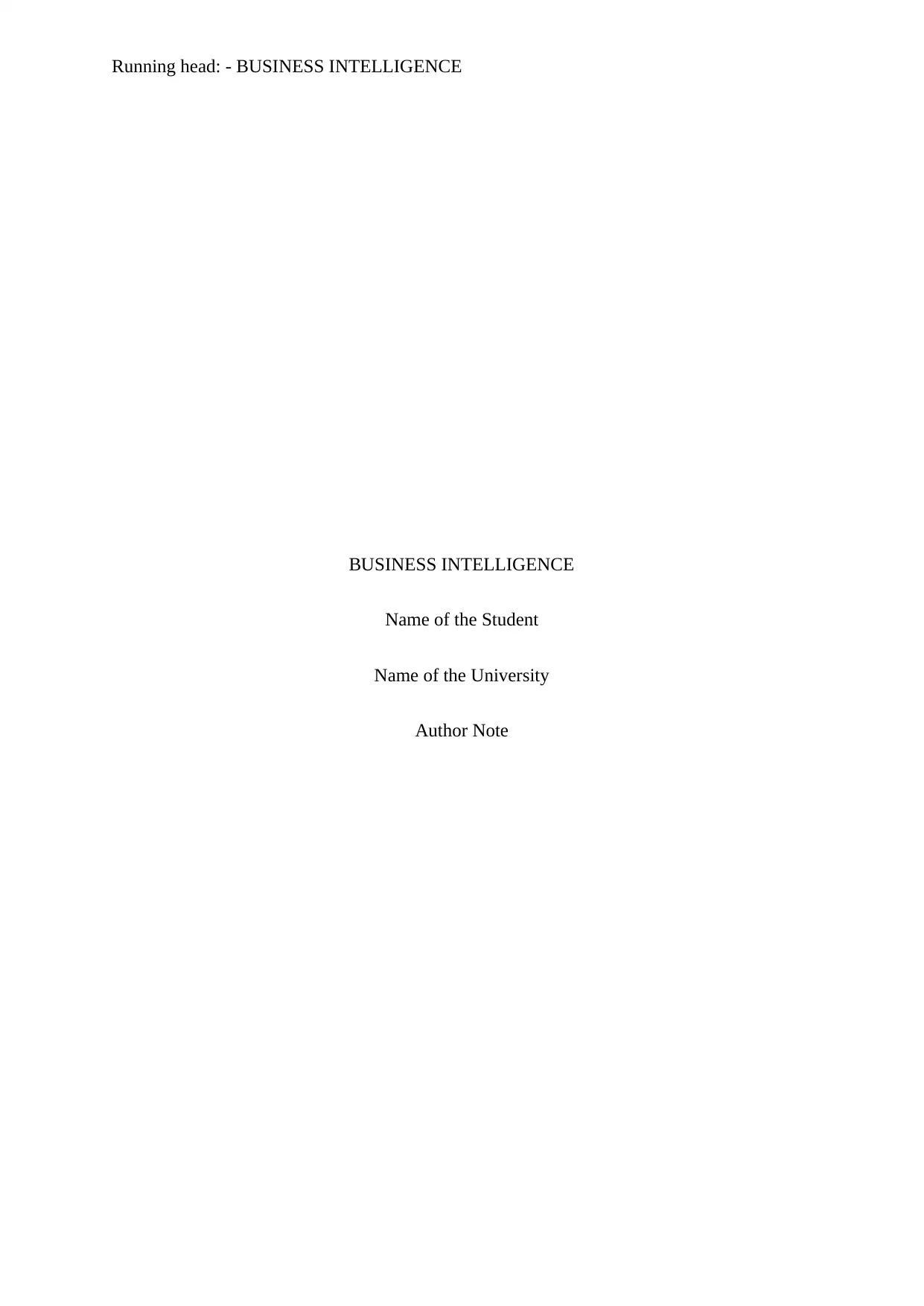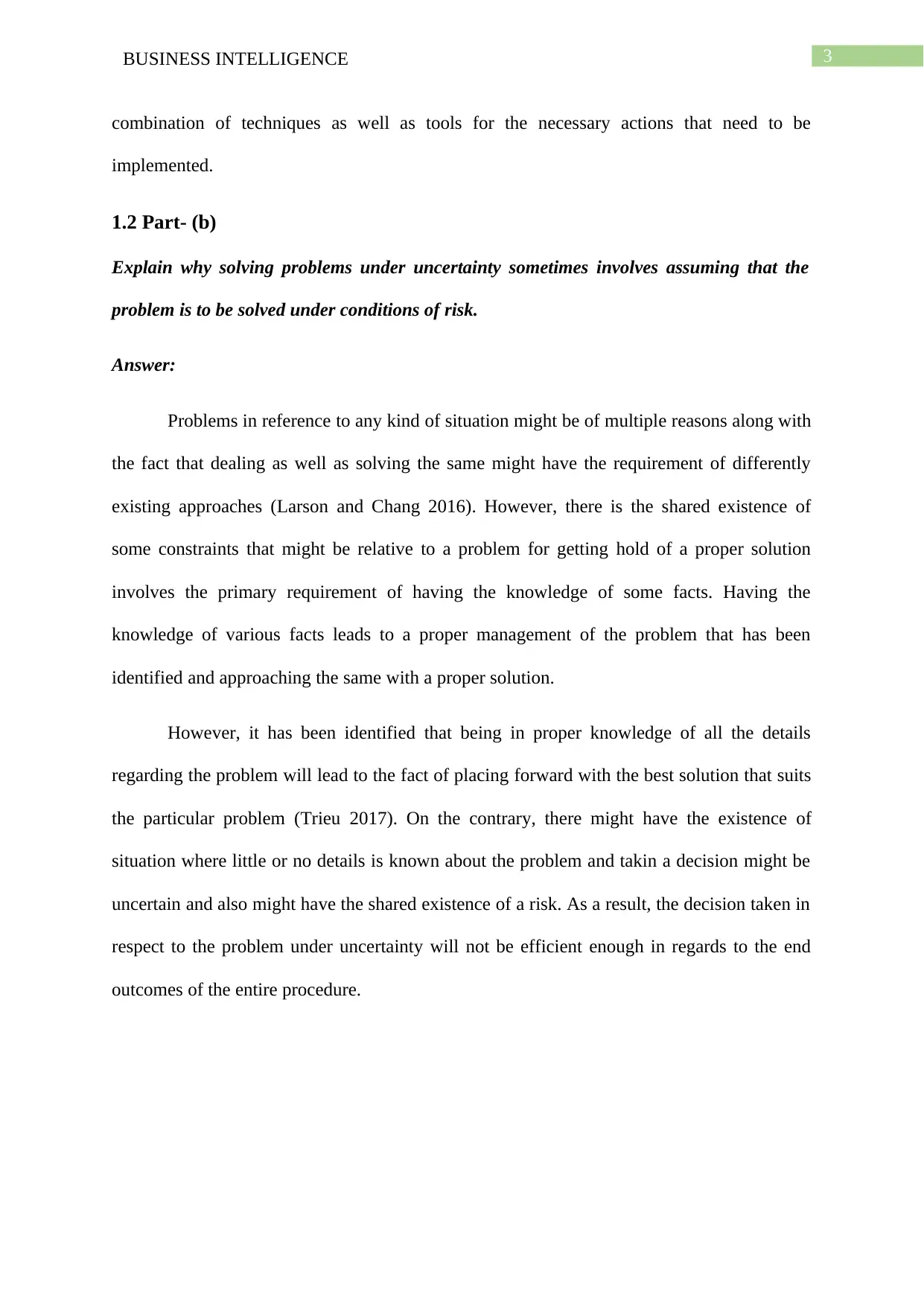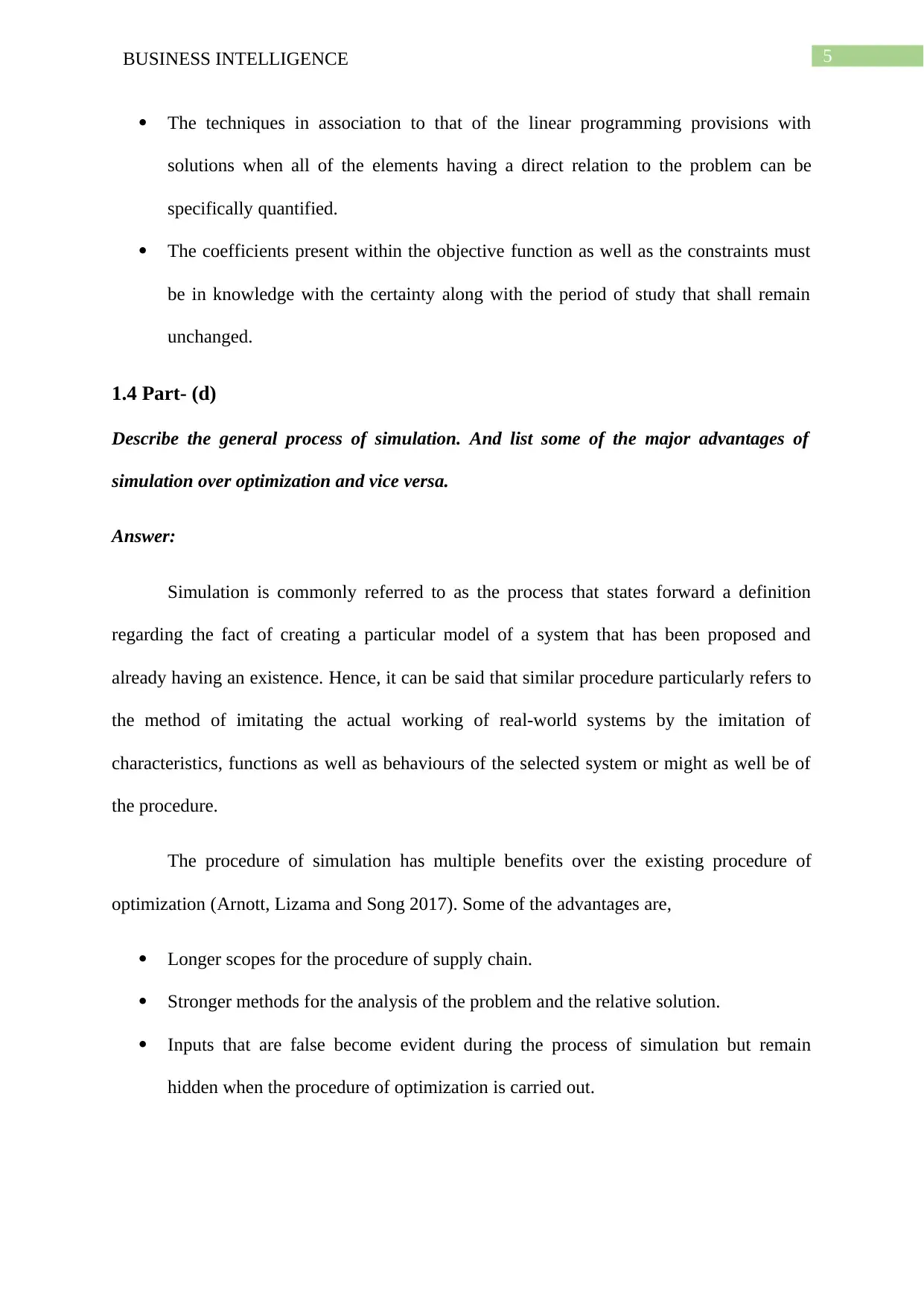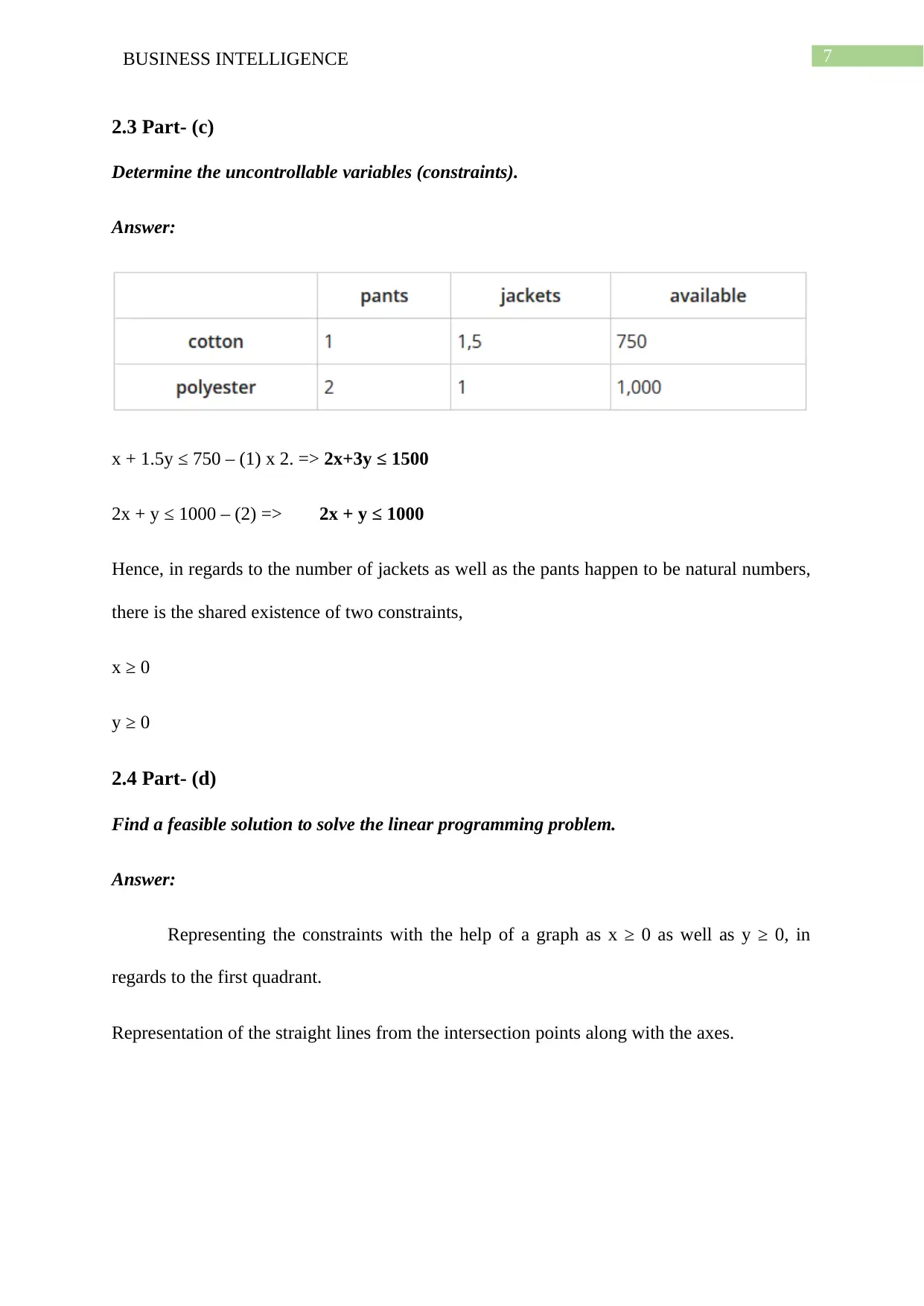Business Intelligence Assignment: Question 1 and 2 Solutions
VerifiedAdded on 2022/08/08
|10
|1666
|248
Homework Assignment
AI Summary
This document provides a comprehensive solution to a Business Intelligence assignment. It begins by exploring the relationship between prescriptive, descriptive, and predictive analytics, explaining their roles and applications. The solution then delves into problem-solving under uncertainty, discussing the relevance of risk. Furthermore, the document examines how Linear Programming (LP) can address allocation problems, outlining the advantages and disadvantages of using LP packages. It also describes the general process of simulation, comparing its advantages over optimization. The assignment concludes by analyzing a specific linear programming problem, including the determination of decision variables, the objective function, uncontrollable variables (constraints), and a feasible solution represented graphically. The assignment covers key concepts and provides detailed solutions for effective learning and understanding of Business Intelligence principles.

Running head: - BUSINESS INTELLIGENCE
BUSINESS INTELLIGENCE
Name of the Student
Name of the University
Author Note
BUSINESS INTELLIGENCE
Name of the Student
Name of the University
Author Note
Paraphrase This Document
Need a fresh take? Get an instant paraphrase of this document with our AI Paraphraser

1BUSINESS INTELLIGENCE
Table of Contents
1. Question-1..............................................................................................................................2
1.1 Part- (a).............................................................................................................................2
1.2 Part- (b)............................................................................................................................3
1.3 Part- (c).............................................................................................................................4
1.4 Part- (d)............................................................................................................................5
2. Question-2..............................................................................................................................6
2.1 Part- (a).............................................................................................................................6
2.2 Part- (b)............................................................................................................................6
2.3 Part- (c).............................................................................................................................7
2.4 Part- (d)............................................................................................................................7
3. References..............................................................................................................................9
Table of Contents
1. Question-1..............................................................................................................................2
1.1 Part- (a).............................................................................................................................2
1.2 Part- (b)............................................................................................................................3
1.3 Part- (c).............................................................................................................................4
1.4 Part- (d)............................................................................................................................5
2. Question-2..............................................................................................................................6
2.1 Part- (a).............................................................................................................................6
2.2 Part- (b)............................................................................................................................6
2.3 Part- (c).............................................................................................................................7
2.4 Part- (d)............................................................................................................................7
3. References..............................................................................................................................9

2BUSINESS INTELLIGENCE
1. Question-1
1.1 Part- (a)
How does prescriptive analytics relate to descriptive and predictive analytics?
Answer:
Prescriptive analytics refers to the procedure of gathering the predictive data to that of
the next overlying level. The relative field of prescriptive analytics provisions the user with
the allowance to prescribe with multiple number of possible actions as well as guide towards
a definite solution to an underlying problem (Laursen and Thorlund 2016). Prescriptive
analytics attempts towards the quantifying the particular effect of the decisions taken in
future for the advising upon the possible outcomes before all of the decisions are
incorporated.
Descriptive analytics carry out the activity of describing or summarizing the raw data
as well as to develop something that is specifically interpretable by the humans in real life.
Hence, this states forward the fact that this analytics deals with the past events that have
necessarily occurred somewhere in the past at some specific point of time.
Lastly, predictive analytics provisions the enterprises with the allowances with all the
actionable insights that has a complete dependency upon the data (Alpar and Schulz 2016).
This also puts forward the provision for estimating about the possibility of some future
outcome that might potentially take place.
Both of the descriptive as well as the predictive analytics deal with periodical
scenarios that have taken place or might have the potentially to occur and provision doable
action in reference to the same. However, the prescripti8ve analytics provisions with multiple
1. Question-1
1.1 Part- (a)
How does prescriptive analytics relate to descriptive and predictive analytics?
Answer:
Prescriptive analytics refers to the procedure of gathering the predictive data to that of
the next overlying level. The relative field of prescriptive analytics provisions the user with
the allowance to prescribe with multiple number of possible actions as well as guide towards
a definite solution to an underlying problem (Laursen and Thorlund 2016). Prescriptive
analytics attempts towards the quantifying the particular effect of the decisions taken in
future for the advising upon the possible outcomes before all of the decisions are
incorporated.
Descriptive analytics carry out the activity of describing or summarizing the raw data
as well as to develop something that is specifically interpretable by the humans in real life.
Hence, this states forward the fact that this analytics deals with the past events that have
necessarily occurred somewhere in the past at some specific point of time.
Lastly, predictive analytics provisions the enterprises with the allowances with all the
actionable insights that has a complete dependency upon the data (Alpar and Schulz 2016).
This also puts forward the provision for estimating about the possibility of some future
outcome that might potentially take place.
Both of the descriptive as well as the predictive analytics deal with periodical
scenarios that have taken place or might have the potentially to occur and provision doable
action in reference to the same. However, the prescripti8ve analytics provisions with multiple
⊘ This is a preview!⊘
Do you want full access?
Subscribe today to unlock all pages.

Trusted by 1+ million students worldwide

3BUSINESS INTELLIGENCE
combination of techniques as well as tools for the necessary actions that need to be
implemented.
1.2 Part- (b)
Explain why solving problems under uncertainty sometimes involves assuming that the
problem is to be solved under conditions of risk.
Answer:
Problems in reference to any kind of situation might be of multiple reasons along with
the fact that dealing as well as solving the same might have the requirement of differently
existing approaches (Larson and Chang 2016). However, there is the shared existence of
some constraints that might be relative to a problem for getting hold of a proper solution
involves the primary requirement of having the knowledge of some facts. Having the
knowledge of various facts leads to a proper management of the problem that has been
identified and approaching the same with a proper solution.
However, it has been identified that being in proper knowledge of all the details
regarding the problem will lead to the fact of placing forward with the best solution that suits
the particular problem (Trieu 2017). On the contrary, there might have the existence of
situation where little or no details is known about the problem and takin a decision might be
uncertain and also might have the shared existence of a risk. As a result, the decision taken in
respect to the problem under uncertainty will not be efficient enough in regards to the end
outcomes of the entire procedure.
combination of techniques as well as tools for the necessary actions that need to be
implemented.
1.2 Part- (b)
Explain why solving problems under uncertainty sometimes involves assuming that the
problem is to be solved under conditions of risk.
Answer:
Problems in reference to any kind of situation might be of multiple reasons along with
the fact that dealing as well as solving the same might have the requirement of differently
existing approaches (Larson and Chang 2016). However, there is the shared existence of
some constraints that might be relative to a problem for getting hold of a proper solution
involves the primary requirement of having the knowledge of some facts. Having the
knowledge of various facts leads to a proper management of the problem that has been
identified and approaching the same with a proper solution.
However, it has been identified that being in proper knowledge of all the details
regarding the problem will lead to the fact of placing forward with the best solution that suits
the particular problem (Trieu 2017). On the contrary, there might have the existence of
situation where little or no details is known about the problem and takin a decision might be
uncertain and also might have the shared existence of a risk. As a result, the decision taken in
respect to the problem under uncertainty will not be efficient enough in regards to the end
outcomes of the entire procedure.
Paraphrase This Document
Need a fresh take? Get an instant paraphrase of this document with our AI Paraphraser

4BUSINESS INTELLIGENCE
1.3 Part- (c)
Explain how LP can solve allocation problems. What are the advantages of using an LP
package to create and solve LP models? What are the disadvantages?
Answer:
Linear Programming (LP) refers to a specific technique that has been designed to
provision the operations manager with a helping hand towards planning as well as making
decisions that have a complete relevance with the trade-offs having the necessity to allocate
resources (Ain et al. 2019). It can be further explained with the fact that the particular method
of mathematical programming for the purpose of resolving problems have a direct association
with the method of resource allocation.
Advantages of linear programming,
Linear programming is utilized for the purpose of minimizing the cost related to that
of production for having the maximum amount of output. Hence, it can be said that
with a helping hand from the models in relation to that of linear programming, the
decision maker can have an efficient as well as effective employment of the
production factor for generating the maximum amount of profit for inputting with the
minimum cost.
Disadvantages of linear programming,
The methods of linear programming can be particularly applied to that of the
objective function as well the other existing constraints expressed within the linear
equation with the help of the terms (Yeoh and Popovič 2016).
1.3 Part- (c)
Explain how LP can solve allocation problems. What are the advantages of using an LP
package to create and solve LP models? What are the disadvantages?
Answer:
Linear Programming (LP) refers to a specific technique that has been designed to
provision the operations manager with a helping hand towards planning as well as making
decisions that have a complete relevance with the trade-offs having the necessity to allocate
resources (Ain et al. 2019). It can be further explained with the fact that the particular method
of mathematical programming for the purpose of resolving problems have a direct association
with the method of resource allocation.
Advantages of linear programming,
Linear programming is utilized for the purpose of minimizing the cost related to that
of production for having the maximum amount of output. Hence, it can be said that
with a helping hand from the models in relation to that of linear programming, the
decision maker can have an efficient as well as effective employment of the
production factor for generating the maximum amount of profit for inputting with the
minimum cost.
Disadvantages of linear programming,
The methods of linear programming can be particularly applied to that of the
objective function as well the other existing constraints expressed within the linear
equation with the help of the terms (Yeoh and Popovič 2016).

5BUSINESS INTELLIGENCE
The techniques in association to that of the linear programming provisions with
solutions when all of the elements having a direct relation to the problem can be
specifically quantified.
The coefficients present within the objective function as well as the constraints must
be in knowledge with the certainty along with the period of study that shall remain
unchanged.
1.4 Part- (d)
Describe the general process of simulation. And list some of the major advantages of
simulation over optimization and vice versa.
Answer:
Simulation is commonly referred to as the process that states forward a definition
regarding the fact of creating a particular model of a system that has been proposed and
already having an existence. Hence, it can be said that similar procedure particularly refers to
the method of imitating the actual working of real-world systems by the imitation of
characteristics, functions as well as behaviours of the selected system or might as well be of
the procedure.
The procedure of simulation has multiple benefits over the existing procedure of
optimization (Arnott, Lizama and Song 2017). Some of the advantages are,
Longer scopes for the procedure of supply chain.
Stronger methods for the analysis of the problem and the relative solution.
Inputs that are false become evident during the process of simulation but remain
hidden when the procedure of optimization is carried out.
The techniques in association to that of the linear programming provisions with
solutions when all of the elements having a direct relation to the problem can be
specifically quantified.
The coefficients present within the objective function as well as the constraints must
be in knowledge with the certainty along with the period of study that shall remain
unchanged.
1.4 Part- (d)
Describe the general process of simulation. And list some of the major advantages of
simulation over optimization and vice versa.
Answer:
Simulation is commonly referred to as the process that states forward a definition
regarding the fact of creating a particular model of a system that has been proposed and
already having an existence. Hence, it can be said that similar procedure particularly refers to
the method of imitating the actual working of real-world systems by the imitation of
characteristics, functions as well as behaviours of the selected system or might as well be of
the procedure.
The procedure of simulation has multiple benefits over the existing procedure of
optimization (Arnott, Lizama and Song 2017). Some of the advantages are,
Longer scopes for the procedure of supply chain.
Stronger methods for the analysis of the problem and the relative solution.
Inputs that are false become evident during the process of simulation but remain
hidden when the procedure of optimization is carried out.
⊘ This is a preview!⊘
Do you want full access?
Subscribe today to unlock all pages.

Trusted by 1+ million students worldwide

6BUSINESS INTELLIGENCE
On the other hand, the benefit of optimization over the procedure of simulation is
primarily the fact that with the help of optimization, there is the possibility of getting
outcomes in various forms as options while on the other hand simulation procedure only
provisions with single results.
2. Question-2
2.1 Part- (a)
Determine the decision variables.
Answer:
The decision variables have been allocated as follows,
x = number of pants for obtaining maximum sale.
y = number of jackets for obtaining maximum sale.
2.2 Part- (b)
Determine the result variable and the objective function.
Answer:
The result variable that have been assumed are,
x = number of pants for obtaining maximum sale.
y = number of jackets for obtaining maximum sale.
The objective function is,
f(x, y)= 50x + 40y
On the other hand, the benefit of optimization over the procedure of simulation is
primarily the fact that with the help of optimization, there is the possibility of getting
outcomes in various forms as options while on the other hand simulation procedure only
provisions with single results.
2. Question-2
2.1 Part- (a)
Determine the decision variables.
Answer:
The decision variables have been allocated as follows,
x = number of pants for obtaining maximum sale.
y = number of jackets for obtaining maximum sale.
2.2 Part- (b)
Determine the result variable and the objective function.
Answer:
The result variable that have been assumed are,
x = number of pants for obtaining maximum sale.
y = number of jackets for obtaining maximum sale.
The objective function is,
f(x, y)= 50x + 40y
Paraphrase This Document
Need a fresh take? Get an instant paraphrase of this document with our AI Paraphraser

7BUSINESS INTELLIGENCE
2.3 Part- (c)
Determine the uncontrollable variables (constraints).
Answer:
x + 1.5y ≤ 750 – (1) x 2. => 2x+3y ≤ 1500
2x + y ≤ 1000 – (2) => 2x + y ≤ 1000
Hence, in regards to the number of jackets as well as the pants happen to be natural numbers,
there is the shared existence of two constraints,
x ≥ 0
y ≥ 0
2.4 Part- (d)
Find a feasible solution to solve the linear programming problem.
Answer:
Representing the constraints with the help of a graph as x ≥ 0 as well as y ≥ 0, in
regards to the first quadrant.
Representation of the straight lines from the intersection points along with the axes.
2.3 Part- (c)
Determine the uncontrollable variables (constraints).
Answer:
x + 1.5y ≤ 750 – (1) x 2. => 2x+3y ≤ 1500
2x + y ≤ 1000 – (2) => 2x + y ≤ 1000
Hence, in regards to the number of jackets as well as the pants happen to be natural numbers,
there is the shared existence of two constraints,
x ≥ 0
y ≥ 0
2.4 Part- (d)
Find a feasible solution to solve the linear programming problem.
Answer:
Representing the constraints with the help of a graph as x ≥ 0 as well as y ≥ 0, in
regards to the first quadrant.
Representation of the straight lines from the intersection points along with the axes.

8BUSINESS INTELLIGENCE
The area of intersection belonging to the solution of the existing dissimilarities will
place forward the explanation in regards to the variation system that displays the set of
feasible solutions.
The graph for the feasible solution is,
The area of intersection belonging to the solution of the existing dissimilarities will
place forward the explanation in regards to the variation system that displays the set of
feasible solutions.
The graph for the feasible solution is,
⊘ This is a preview!⊘
Do you want full access?
Subscribe today to unlock all pages.

Trusted by 1+ million students worldwide

9BUSINESS INTELLIGENCE
3. References
Ain, N., Vaia, G., DeLone, W.H. and Waheed, M., 2019. Two decades of research on
business intelligence system adoption, utilization and success–A systematic literature review.
Decision Support Systems, 125, p.113113.
Alpar, P. and Schulz, M., 2016. Self-service business intelligence. Business & Information
Systems Engineering, 58(2), pp.151-155.
Arnott, D., Lizama, F. and Song, Y., 2017. Patterns of business intelligence systems use in
organizations. Decision Support Systems, 97, pp.58-68.
Larson, D. and Chang, V., 2016. A review and future direction of agile, business intelligence,
analytics and data science. International Journal of Information Management, 36(5), pp.700-
710.
Laursen, G.H. and Thorlund, J., 2016. Business analytics for managers: Taking business
intelligence beyond reporting. John Wiley & Sons.
Trieu, V.H., 2017. Getting value from Business Intelligence systems: A review and research
agenda. Decision Support Systems, 93, pp.111-124.
Yeoh, W. and Popovič, A., 2016. Extending the understanding of critical success factors for
implementing business intelligence systems. Journal of the Association for Information
Science and Technology, 67(1), pp.134-147.
3. References
Ain, N., Vaia, G., DeLone, W.H. and Waheed, M., 2019. Two decades of research on
business intelligence system adoption, utilization and success–A systematic literature review.
Decision Support Systems, 125, p.113113.
Alpar, P. and Schulz, M., 2016. Self-service business intelligence. Business & Information
Systems Engineering, 58(2), pp.151-155.
Arnott, D., Lizama, F. and Song, Y., 2017. Patterns of business intelligence systems use in
organizations. Decision Support Systems, 97, pp.58-68.
Larson, D. and Chang, V., 2016. A review and future direction of agile, business intelligence,
analytics and data science. International Journal of Information Management, 36(5), pp.700-
710.
Laursen, G.H. and Thorlund, J., 2016. Business analytics for managers: Taking business
intelligence beyond reporting. John Wiley & Sons.
Trieu, V.H., 2017. Getting value from Business Intelligence systems: A review and research
agenda. Decision Support Systems, 93, pp.111-124.
Yeoh, W. and Popovič, A., 2016. Extending the understanding of critical success factors for
implementing business intelligence systems. Journal of the Association for Information
Science and Technology, 67(1), pp.134-147.
1 out of 10
Related Documents
Your All-in-One AI-Powered Toolkit for Academic Success.
+13062052269
info@desklib.com
Available 24*7 on WhatsApp / Email
![[object Object]](/_next/static/media/star-bottom.7253800d.svg)
Unlock your academic potential
Copyright © 2020–2025 A2Z Services. All Rights Reserved. Developed and managed by ZUCOL.




